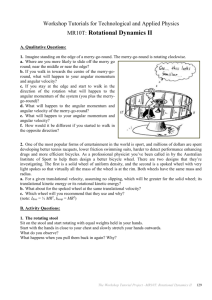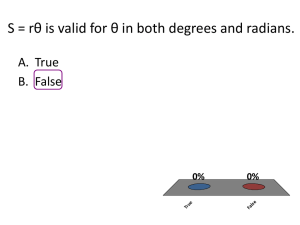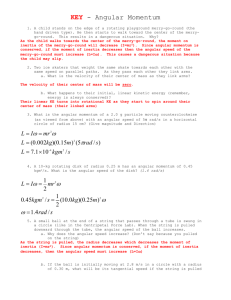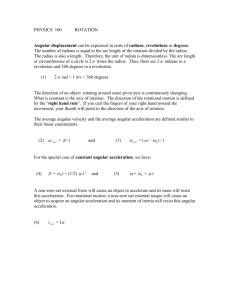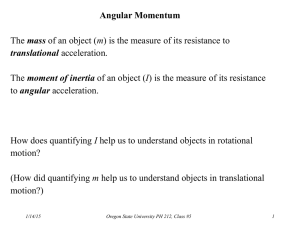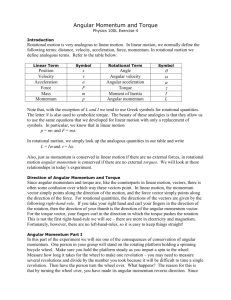rotational dynamics 2 – angular momentum
advertisement
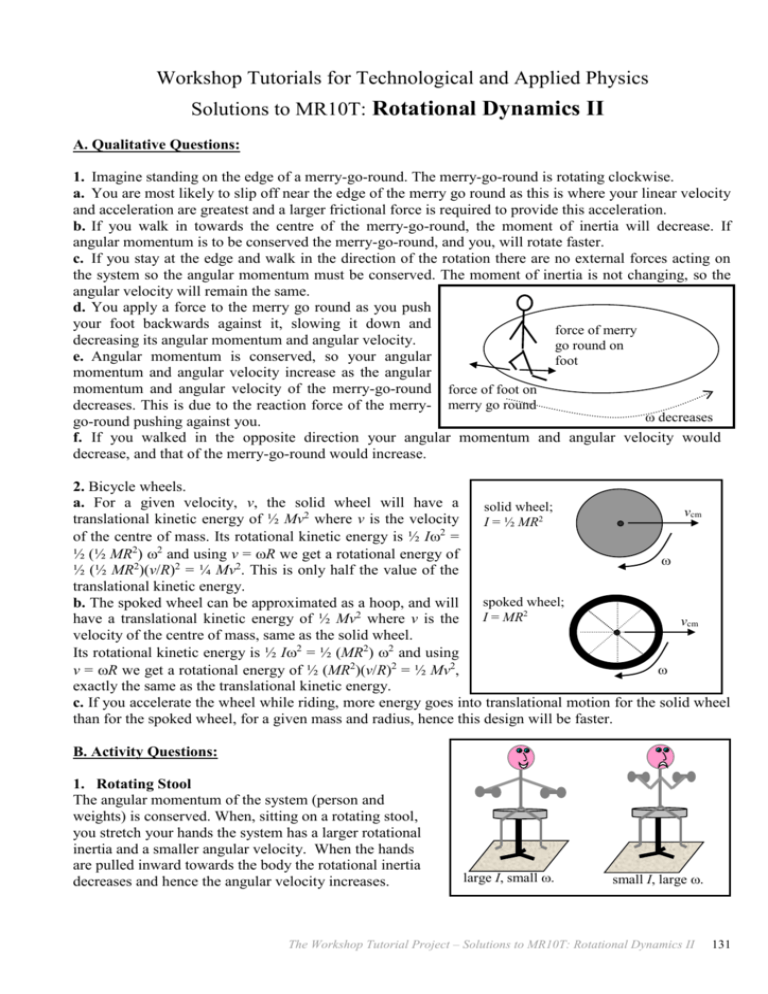
Workshop Tutorials for Technological and Applied Physics Solutions to MR10T: Rotational Dynamics II A. Qualitative Questions: 1. Imagine standing on the edge of a merry-go-round. The merry-go-round is rotating clockwise. a. You are most likely to slip off near the edge of the merry go round as this is where your linear velocity and acceleration are greatest and a larger frictional force is required to provide this acceleration. b. If you walk in towards the centre of the merry-go-round, the moment of inertia will decrease. If angular momentum is to be conserved the merry-go-round, and you, will rotate faster. c. If you stay at the edge and walk in the direction of the rotation there are no external forces acting on the system so the angular momentum must be conserved. The moment of inertia is not changing, so the angular velocity will remain the same. d. You apply a force to the merry go round as you push your foot backwards against it, slowing it down and force of merry decreasing its angular momentum and angular velocity. go round on e. Angular momentum is conserved, so your angular foot momentum and angular velocity increase as the angular momentum and angular velocity of the merry-go-round force of foot on decreases. This is due to the reaction force of the merry- merry go round decreases go-round pushing against you. f. If you walked in the opposite direction your angular momentum and angular velocity would decrease, and that of the merry-go-round would increase. 2. Bicycle wheels. a. For a given velocity, v, the solid wheel will have a solid wheel; vcm translational kinetic energy of ½ Mv2 where v is the velocity I = ½ MR2 of the centre of mass. Its rotational kinetic energy is ½ I2 = ½ (½ MR2) 2 and using v = R we get a rotational energy of ½ (½ MR2)(v/R)2 = ¼ Mv2. This is only half the value of the translational kinetic energy. spoked wheel; b. The spoked wheel can be approximated as a hoop, and will 2 I = MR2 have a translational kinetic energy of ½ Mv where v is the vcm velocity of the centre of mass, same as the solid wheel. Its rotational kinetic energy is ½ I2 = ½ (MR2) 2 and using v = R we get a rotational energy of ½ (MR2)(v/R)2 = ½ Mv2, exactly the same as the translational kinetic energy. c. If you accelerate the wheel while riding, more energy goes into translational motion for the solid wheel than for the spoked wheel, for a given mass and radius, hence this design will be faster. B. Activity Questions: 1. Rotating Stool The angular momentum of the system (person and weights) is conserved. When, sitting on a rotating stool, you stretch your hands the system has a larger rotational inertia and a smaller angular velocity. When the hands are pulled inward towards the body the rotational inertia decreases and hence the angular velocity increases. large I, small . small I, large . The Workshop Tutorial Project – Solutions to MR10T: Rotational Dynamics II 131 2. Falling cats Conservation of angular momentum is not violated, at any time your total angular momentum is zero. The procedure is as follows: 1. Falling with all four limbs sticking straight out. 2. Pull in front legs (arms) and rotate them 60o clockwise. Outstretched rear legs have to rotate 300 anti-clockwise. 3. Extend front legs (arms) and rotate them 30oanti-clockwise, and pull in back legs which have to rotate 60o clockwise. You should now be rotated 30o clockwise. Repeat this 5 times and you’ll be facing the right way and ready to land! 3. Bicycle wheel If the wheel is not spinning it is easy to tilt it from side to side. When the wheel is spinning it can be very difficult to tilt it, and you feel it exerting a large force on you. When a person sitting on the rotating stool tries to tilt the wheel they also feel the force that it exerts on them, but they are not held stationary to the ground by friction, so they begin to rotate with the stool. Angular momentum is conserved - when the person changes the angular momentum of the wheel by tilting it, their angular momentum must change also. (Remember that angular momentum is a vector quantity, it changes when the direction or plane of rotation changes, not only when the angular speed changes.) C. Quantitative Questions: 1. As the student moves in from the rim his moment of inertia changes and so the total moment of inertia of the system (platform + student) changes. Since the interaction occurs between the student and the platform we can regard this as a collision and angular momentum (I) is conserved. The moment of inertia of the student is Is = msrs2. Now (I)i = (I)f so, (IpIsi)i = (IpIsf)f , so: ( I p I si ) i ( 300 kg.m 2 60 kg (2 m)2 )1.5 rad.s -1 f = ( I p I sf ) = = 2.6 rad.s-1. ( 300 kg.m 2 60 kg (0.5 m)2 ) 2. Pushing discs together. a. When the net external torque acting on the system of the two discs is zero, the angular momentum of the system is conserved. The external forces are along the axis of rotation and thus exert no torque about this axis. The only torque acting on either disk is the torque applied by the other disk, these are internal torques so angular momentum is conserved. At the end they rotate together as one body with total rotational inertia I = IA + IB and angular velocity . Conservation of angular momentum gives IAA + IBB = (IA + IB), rearranging for gives: = I A A I B B IA IB B A IA IB IA + IB b. The rotational inertia of the two disks are IA = ½ mArA2 = ½ × 2.0 kg × (0.20 m)2 = 0.040 kg.m2 and IB = ½ mBrB2 = ½ × 4.0 kg × (0.10 m)2 = 0.020 kg.m2. Using our answer to part a gives: I A A I B B 0.04kg.m2 50rad.s 1 0.02kg.m2 200rad.s 1 = = = 100 rad.s-1. IA IB 0.04kg.m2 0.02kg.m2 c. KEi = ½ IAA2 + ½ IBB2 = ½ × 0.040 kg.m2 × (50 rad.s-1)2 + ½ × 0.020 kg.m2 × (200 rad.s-1)2 = 450 J. KEf = ½ (IA+ IB)2 = ½ × (0.040 kg.m2 + 0.020 kg.m2) × (100 rad.s-1)2 = 300 J. Kinetic energy has not been conserved, even though the resultant external force and torque are zero, because non conservative (frictional) internal forces act while the two disks rub together as they gradually approach a common angular velocity. 132 The Workshop Tutorial Project – Solutions to MR10T: Rotational Dynamics II


